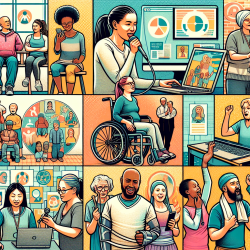Introduction
In the realm of health justice, understanding the intersection of disability and health outcomes is crucial. The research article "Locating Disability Within a Health Justice Framework" offers a comprehensive exploration of how disability should be integrated into health justice discussions. This blog post will delve into the key insights from the article and how practitioners, especially those involved in online therapy services like TinyEYE, can leverage these insights to improve outcomes for children and individuals with disabilities.
Disability as a Demographic and Health Outcome
The research emphasizes the need to view disability not merely as a health outcome but as a critical demographic factor. This shift in perspective allows for a more robust understanding of health inequities and opens up new pathways for legal and policy interventions. For practitioners, this means recognizing the socio-political identity of disability and how it intersects with other marginalized identities such as race, gender, and socio-economic status.
Practical Implications for Practitioners
Practitioners can enhance their skills by incorporating the following strategies:
- Adopt an Intersectional Approach: Recognize the overlapping identities and experiences of individuals with disabilities. This understanding can guide more personalized and effective interventions.
- Focus on Structural Barriers: Identify and address systemic barriers that individuals with disabilities face, such as access to healthcare, education, and employment opportunities.
- Promote Inclusive Practices: Implement practices that are inclusive and accessible, ensuring that all individuals, regardless of their abilities, can benefit from services.
Encouraging Further Research
The article calls for greater integration of disability into health justice scholarship and practice. Practitioners are encouraged to engage in further research to explore the complexities of disability as a socio-political identity. By doing so, they can contribute to a more comprehensive understanding of health justice and advocate for more equitable policies and practices.
Conclusion
Integrating disability into the health justice framework is not just about addressing health outcomes but recognizing disability as a vital demographic factor. Practitioners, especially those in online therapy services, can play a significant role in advancing health justice by adopting intersectional approaches, focusing on structural barriers, and promoting inclusive practices. By doing so, they can contribute to creating better outcomes for children and individuals with disabilities.
To read the original research paper, please follow this link: Locating Disability Within a Health Justice Framework.










